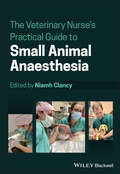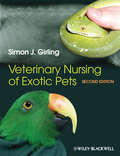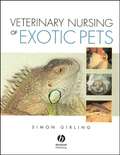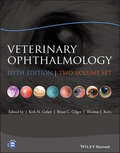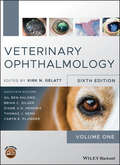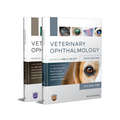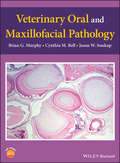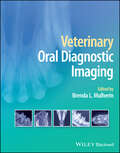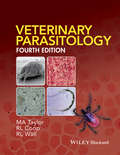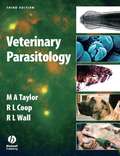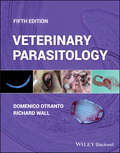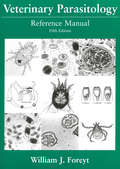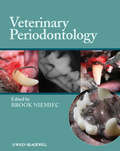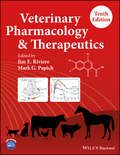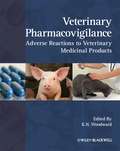- Table View
- List View
The Veterinary Nurse's Practical Guide to Small Animal Anaesthesia
by Niamh ClancyAn accessible guide to small animal anaesthesia for the veterinary practice The Veterinary Nurse’s Practical Guide to Small Animal Anaesthesia meets the need for a single practical guide to veterinary anaesthesia and its potential complications. Written by practicing veterinary nurses, the guide analyzes each stage in turn, beginning with a discussion of pre-assessment and pre-medication of patients. Most critically, it reviews the normal functioning of each physiological system in small animals before detailing common problems caused in these systems by anaesthesia. Developed for the day-to-day needs of veterinary nurses, readers will also find: Step-by-step guides to addressing specific issues such as GDV, brachycephalic patients, aggressive patients, and more Detailed guidelines for interpreting common test results and biometrics such as capnography and ECGs Chapters designed for easy reference in specific emergency situationsThe Veterinary Nurse’s Practical Guide to Small Animal Anaesthesia is an essential tool for veterinary nurses and veterinary technicians.
Veterinary Nursing of Exotic Pets
by Simon J. GirlingVeterinary Nursing of Exotic Pets is the definitive reference book on the principles and practice of nursing exotic species. From rabbits and chinchillas to budgies and iguanas, it not only covers husbandry, nutrition and handling, but provides an overview of diseases and treatments, and explores anatomy and chemical restraint. The redesigned layout and full colour artwork make it quicker and easier to find exactly what you’re looking for. New coverage for this revised and enlarged second edition includes: emergency and critical care, radiography, and small marsupials such as sugargliders. In addition to the thorough explanations of appropriate home-care which will enable you to confidently advise clients, the book now also covers the care of hospitalised exotics. Key features: Provides an understanding of the basics of diseases, husbandry, anatomy and physiology of exotic pets as outlined by the RCVS examinations Gives veterinary nurses the confidence to discuss exotic pets with clients by providing a solid knowledge base in these species. This book acts as a companion to the City and Guilds NVQ level 4 equivalent qualification 'Veterinary Nursing of Exotic Species'. Suitable for veterinary nurses, veterinary technicians and veterinary students.
Veterinary Nursing of Exotic Pets
by Simon J. GirlingVeterinary Nursing of Exotic Pets is the definitive reference book on the principles and practice of nursing exotic species. From rabbits and chinchillas to budgies and iguanas, it not only covers husbandry, nutrition and handling, but provides an overview of diseases and treatments, and explores anatomy and chemical restraint. The redesigned layout and full colour artwork make it quicker and easier to find exactly what you’re looking for. New coverage for this revised and enlarged second edition includes: emergency and critical care, radiography, and small marsupials such as sugargliders. In addition to the thorough explanations of appropriate home-care which will enable you to confidently advise clients, the book now also covers the care of hospitalised exotics. Key features: Provides an understanding of the basics of diseases, husbandry, anatomy and physiology of exotic pets as outlined by the RCVS examinations Gives veterinary nurses the confidence to discuss exotic pets with clients by providing a solid knowledge base in these species. This book acts as a companion to the City and Guilds NVQ level 4 equivalent qualification 'Veterinary Nursing of Exotic Species'. Suitable for veterinary nurses, veterinary technicians and veterinary students.
Veterinary Nursing of Exotic Pets
by Simon J. GirlingFrom budgies and cockatiels to chipmunks and chinchillas, our interest in exotic pets has rocketed in recent years. With the house rabbit being the UK's third most commonly kept pet after the cat and dog, and sales in small mammals, reptiles and birds continuing to grow, exotic pets have now become a specialist area of veterinary practice in their own right. Veterinary Nursing of Exotic Pets is the first book to address the need for a definitive reference book devoted entirely to the principles and applications of nursing exotic species. Developed from a City and Guild's course, it not only covers husbandry, nutrition and handling, but also explores anatomy and chemical restraint, and provides an overview of diseases and treatments.
Veterinary Ophthalmology: Two Volume Set
by Kirk N. Gelatt Brian C. Gilger Thomas J. KernVeterinary Ophthalmology, Fifth Edition is a fully updated version of the gold-standard reference for diseases and treatment of the animal eye in veterinary medicine. With an internationally renowned list of contributing authors, the book has been revised and expanded to incorporate the most up-to-date research and information. New chapters cover ophthalmic genetics and DNA tests, microsurgery, photography, camelid ophthalmology, and rabbit ophthalmology, and existing chapters feature expanded coverage of noninvasive imaging techniques, feline ophthalmology, equine ophthalmology, and marine mammals and penguins. The book retains its classic structure, with sections on basic vision sciences, the foundations of clinical ophthalmology, canine ophthalmology, and special ophthalmology, which encompasses specific coverage of most commonly treated species and chapters on neuro-ophthalmology and systemic diseases. A companion website offers the images from the book available for download in PowerPoint and the references linked to CrossRef. Veterinary Ophthalmology remains the most comprehensive resource for authoritative information on veterinary ophthalmology worldwide and is a key reference for anyone interested in veterinary or comparative ophthalmology.
Veterinary Ophthalmology: Two Volume Set
by Kirk N. Gelatt Brian C. Gilger Thomas J. KernVeterinary Ophthalmology, Fifth Edition is a fully updated version of the gold-standard reference for diseases and treatment of the animal eye in veterinary medicine. With an internationally renowned list of contributing authors, the book has been revised and expanded to incorporate the most up-to-date research and information. New chapters cover ophthalmic genetics and DNA tests, microsurgery, photography, camelid ophthalmology, and rabbit ophthalmology, and existing chapters feature expanded coverage of noninvasive imaging techniques, feline ophthalmology, equine ophthalmology, and marine mammals and penguins. The book retains its classic structure, with sections on basic vision sciences, the foundations of clinical ophthalmology, canine ophthalmology, and special ophthalmology, which encompasses specific coverage of most commonly treated species and chapters on neuro-ophthalmology and systemic diseases. A companion website offers the images from the book available for download in PowerPoint and the references linked to CrossRef. Veterinary Ophthalmology remains the most comprehensive resource for authoritative information on veterinary ophthalmology worldwide and is a key reference for anyone interested in veterinary or comparative ophthalmology.
Veterinary Ophthalmology
by Thomas J. Kern Brian C. Gilger Caryn E. Plummer Gil Ben-Shlomo Diane V. HendrixOffering the very latest in diagnostics and therapeutics, this book presents a fully updated and revised edition of the definitive reference to veterinary ophthalmology. Covering both basic sciences and clinical treatment, it is a state-of-the-art text that encompasses ophthalmology in all species, including dogs, cats, horses, large animals, and exotic animals. Featuring expanded coverage of ocular conditions in cats, horses, and birds—and featuring nearly two thousand color photographs and illustrations—the book is a must for any practitioner treating eye disease. Veterinary Ophthalmology, Sixth Edition discusses all topics relevant to diagnosing, treating, and managing any disease related to the eye. The book also offers a companion website featuring video clips, and images from the book in PowerPoint, and contains the most comprehensive bibliographies found on the subject. Updates the gold-standard reference for veterinary ophthalmology Presents expanded coverage of feline, equine, and avian ophthalmology Incorporates new knowledge on diagnostics and therapeutics to provide a truly state-of-the-art text Provides 2,000 images to illustrate the concepts described Written by an international list of preeminent ophthalmologists Includes access to a companion website with video clips and the images for download in PowerPoint Veterinary Ophthalmology, Sixth Edition is an essential purchase for veterinary ophthalmologists and any practitioner treating ophthalmic diseases.
Veterinary Ophthalmology: Two Volume Set
by Thomas J. Kern Brian C. Gilger Caryn E. Plummer Gil Ben-Shlomo Diane V. HendrixOffering the very latest in diagnostics and therapeutics, this book presents a fully updated and revised edition of the definitive reference to veterinary ophthalmology. Covering both basic sciences and clinical treatment, it is a state-of-the-art text that encompasses ophthalmology in all species, including dogs, cats, horses, large animals, and exotic animals. Featuring expanded coverage of ocular conditions in cats, horses, and birds—and featuring nearly two thousand color photographs and illustrations—the book is a must for any practitioner treating eye disease. Veterinary Ophthalmology, Sixth Edition discusses all topics relevant to diagnosing, treating, and managing any disease related to the eye. The book also offers a companion website featuring video clips, and images from the book in PowerPoint, and contains the most comprehensive bibliographies found on the subject. Updates the gold-standard reference for veterinary ophthalmology Presents expanded coverage of feline, equine, and avian ophthalmology Incorporates new knowledge on diagnostics and therapeutics to provide a truly state-of-the-art text Provides 2,000 images to illustrate the concepts described Written by an international list of preeminent ophthalmologists Includes access to a companion website with video clips and the images for download in PowerPoint Veterinary Ophthalmology, Sixth Edition is an essential purchase for veterinary ophthalmologists and any practitioner treating ophthalmic diseases.
Veterinary Oral and Maxillofacial Pathology
by Brian G. Murphy Cynthia M. Bell Jason W. SoukupVeterinary Oral and Maxillofacial Pathology focuses on methods for establishing a diagnosis and set of differential diagnoses. Provides the only text dedicated solely to veterinary oral and maxillofacial pathology Guides the pathologist through the thought process of diagnosing oral and maxillofacial lesions Focuses on mammalian companion animals, including dogs, cats and horses, with some coverage of ruminants, camelids, and laboratory animal species Features access to video clips narrating the process of histological diagnosis on a companion website
Veterinary Oral and Maxillofacial Pathology
by Brian G. Murphy Cynthia M. Bell Jason W. SoukupVeterinary Oral and Maxillofacial Pathology focuses on methods for establishing a diagnosis and set of differential diagnoses. Provides the only text dedicated solely to veterinary oral and maxillofacial pathology Guides the pathologist through the thought process of diagnosing oral and maxillofacial lesions Focuses on mammalian companion animals, including dogs, cats and horses, with some coverage of ruminants, camelids, and laboratory animal species Features access to video clips narrating the process of histological diagnosis on a companion website
Veterinary Oral Diagnostic Imaging
by Brenda L. MulherinVeterinary Oral Diagnostic Imaging Complete reference on using diagnostic imaging in veterinary dentistry and interpreting diagnostic images in dogs, cats, exotic pets, zoological animals, and horses Veterinary Oral Diagnostic Imaging offers veterinary clinicians a complete guide to using diagnostic imaging for common dentistry and oral surgery procedures in a veterinary practice. It provides guidance on positioning, techniques, and interpreting diagnostic images in the oral cavity, with more than 600 high-quality dental diagnostic images showing both normal anatomy and pathology for comparison. Focusing on dental radiography in dogs, cats, exotic pets, zoological animals, and horses, the book also includes advanced modalities such as MRI, CT, and cone beam CT. Veterinary Oral Diagnostic Imaging covers: History, physiology, and indications for diagnostic imaging of the oral cavity, with information on the history of diagnostic imaging and radiographic image creation Digital dental radiographic positioning and image labeling, covering the parallel technique, bisecting angle, radiographic positioning errors, and labial mounting Interpretation of anatomy, covering normal radiographic anatomy, dentition and tooth numbers, deciduous and permanent teeth of canine and feline patients, eruption patterns and common and uncommon radiographic pathology observed in these animals Standard imaging, radiographic anatomy, and interpretation of equine patients, as well as exotic pocket pets and zoological animals Focusing on the fundamentals of dental radiographic imaging, interpretation, and applications to the oral cavity, Veterinary Oral Diagnostic Imaging is an essential resource for any veterinarian providing dental services as part of their practice, along with veterinary students and interns.
Veterinary Oral Diagnostic Imaging
by Brenda L. MulherinVeterinary Oral Diagnostic Imaging Complete reference on using diagnostic imaging in veterinary dentistry and interpreting diagnostic images in dogs, cats, exotic pets, zoological animals, and horses Veterinary Oral Diagnostic Imaging offers veterinary clinicians a complete guide to using diagnostic imaging for common dentistry and oral surgery procedures in a veterinary practice. It provides guidance on positioning, techniques, and interpreting diagnostic images in the oral cavity, with more than 600 high-quality dental diagnostic images showing both normal anatomy and pathology for comparison. Focusing on dental radiography in dogs, cats, exotic pets, zoological animals, and horses, the book also includes advanced modalities such as MRI, CT, and cone beam CT. Veterinary Oral Diagnostic Imaging covers: History, physiology, and indications for diagnostic imaging of the oral cavity, with information on the history of diagnostic imaging and radiographic image creation Digital dental radiographic positioning and image labeling, covering the parallel technique, bisecting angle, radiographic positioning errors, and labial mounting Interpretation of anatomy, covering normal radiographic anatomy, dentition and tooth numbers, deciduous and permanent teeth of canine and feline patients, eruption patterns and common and uncommon radiographic pathology observed in these animals Standard imaging, radiographic anatomy, and interpretation of equine patients, as well as exotic pocket pets and zoological animals Focusing on the fundamentals of dental radiographic imaging, interpretation, and applications to the oral cavity, Veterinary Oral Diagnostic Imaging is an essential resource for any veterinarian providing dental services as part of their practice, along with veterinary students and interns.
Veterinary Parasitology
by M. A. Taylor R. L. Coop Richard L. WallThe recipient of much praise and acclaim, Veterinary Parasitology is widely considered to be the definitive veterinary parasitology reference for practitioners and students alike. This Fourth Edition has been developed and enhanced into a two-part reference to reflect recent advances in the field, modern teaching practice, and updated parasite taxonomic classification systems. Part One contains expanded individual parasite descriptions using current taxonomic status within three new chapters on Helminthology, Protozoology and Entomology. Further updated chapters are provided on: The laboratory diagnosis of parasitism, Antiparasitics, The epidemiology of parasitic diseases, and Host resistance to parasitic diseases. Host species chapters have been retained and expanded and are found in Part Two of the edition. KEY FEATURES Tailored for those directly involved in the diagnosis, treatment and control of parasitic diseases of domestic animals Compatible with the diversity of current parasitology teaching modules – both for teaching parasite systematics and diseases on a host-organ basis Offers the most detailed parasite descriptions available today for teachers, research groups, veterinarians in practice and in government service, and others involved in aspects of parasitic disease Thoroughly revised and restructured to reflect the most up-to-date advancements in the field, Veterinary Parasitology, Fourth Edition, enhances its stellar reputation as the gold standard reference text for the global veterinary profession.
Veterinary Parasitology
by M. A. Taylor R. L. Coop Richard L. WallLong established as a bestselling parasitology book for veterinary practitioners and veterinary students, the previous edition lead by Urquhart was praised as '...probably the best available veterinary parasitology text for the practitioner' (Clinical Insight). This third edition of Veterinary Parasitology is a major update which builds on the spirit of earlier editions. New authors with a wealth of experience of teaching and researching the subject have thoroughly revised and restructured the book to reflect modern teaching practice and the most up-to-date coverage of advances in this area. *Arranged by host species and organ systems within the host, with extensive cross-referencing to enable ease of access to information on particular parasites. *The core focus is on parasites of livestock and companion animals, but new sections also cover parasites of poultry and gamebirds, laboratory animals, exotic pets and 'farmed' species. *Expanded sections on protozoa and ectoparasites, as well as coverage of a larger selection of parasites of veterinary significance around the world. *The majority of parasitic diseases are now covered in detail using a standardised format for each parasite to allow easy referencing and identification and for comparison between species within a genus. Suitable for veterinary students, as well as researchers of veterinary parasitology, veterinarians in practice and in government service and others who are involved in aspects of parasitic disease. About the authors: Professor Mike Taylor is head of Veterinary Surveillance at the Central Science Laboratory York, UK. He is also a visiting Professor of Parasitology at the Royal Veterinary College, London and at the University of Wales, Bangor, an Honorary Fellow of the University of Edinburgh, as well as a Diplomate of the European College of Veterinary Parasitology, and Editor-in-Chief of Veterinary Parasitology. Dr Bob Coop was formerly Head of the Division of Parasitology at the Moredun Research Institute, Scotland, and is now Honorary Fellow of the Moredun Foundation. He has over 35 years' experience of research in veterinary parasitology. Richard Wall is Professor of Zoology at the University of Bristol, UK, where he teaches and heads an internationally recognized research group working on the ecology, behaviour and control of arthropod parasites and vectors. He has served as veterinary editor of the journal Medical & Veterinary Entomology and President of the British Association for Veterinary Parasitolgy; he is a Fellow of the Royal Entomological Society.
Veterinary Parasitology
by M. A. Taylor R. L. Coop Richard L. WallThe recipient of much praise and acclaim, Veterinary Parasitology is widely considered to be the definitive veterinary parasitology reference for practitioners and students alike. This Fourth Edition has been developed and enhanced into a two-part reference to reflect recent advances in the field, modern teaching practice, and updated parasite taxonomic classification systems. Part One contains expanded individual parasite descriptions using current taxonomic status within three new chapters on Helminthology, Protozoology and Entomology. Further updated chapters are provided on: The laboratory diagnosis of parasitism, Antiparasitics, The epidemiology of parasitic diseases, and Host resistance to parasitic diseases. Host species chapters have been retained and expanded and are found in Part Two of the edition. KEY FEATURES Tailored for those directly involved in the diagnosis, treatment and control of parasitic diseases of domestic animals Compatible with the diversity of current parasitology teaching modules – both for teaching parasite systematics and diseases on a host-organ basis Offers the most detailed parasite descriptions available today for teachers, research groups, veterinarians in practice and in government service, and others involved in aspects of parasitic disease Thoroughly revised and restructured to reflect the most up-to-date advancements in the field, Veterinary Parasitology, Fourth Edition, enhances its stellar reputation as the gold standard reference text for the global veterinary profession.
Veterinary Parasitology
by M. A. Taylor R. L. Coop Richard L. WallLong established as a bestselling parasitology book for veterinary practitioners and veterinary students, the previous edition lead by Urquhart was praised as '...probably the best available veterinary parasitology text for the practitioner' (Clinical Insight). This third edition of Veterinary Parasitology is a major update which builds on the spirit of earlier editions. New authors with a wealth of experience of teaching and researching the subject have thoroughly revised and restructured the book to reflect modern teaching practice and the most up-to-date coverage of advances in this area. *Arranged by host species and organ systems within the host, with extensive cross-referencing to enable ease of access to information on particular parasites. *The core focus is on parasites of livestock and companion animals, but new sections also cover parasites of poultry and gamebirds, laboratory animals, exotic pets and 'farmed' species. *Expanded sections on protozoa and ectoparasites, as well as coverage of a larger selection of parasites of veterinary significance around the world. *The majority of parasitic diseases are now covered in detail using a standardised format for each parasite to allow easy referencing and identification and for comparison between species within a genus. Suitable for veterinary students, as well as researchers of veterinary parasitology, veterinarians in practice and in government service and others who are involved in aspects of parasitic disease. About the authors: Professor Mike Taylor is head of Veterinary Surveillance at the Central Science Laboratory York, UK. He is also a visiting Professor of Parasitology at the Royal Veterinary College, London and at the University of Wales, Bangor, an Honorary Fellow of the University of Edinburgh, as well as a Diplomate of the European College of Veterinary Parasitology, and Editor-in-Chief of Veterinary Parasitology. Dr Bob Coop was formerly Head of the Division of Parasitology at the Moredun Research Institute, Scotland, and is now Honorary Fellow of the Moredun Foundation. He has over 35 years' experience of research in veterinary parasitology. Richard Wall is Professor of Zoology at the University of Bristol, UK, where he teaches and heads an internationally recognized research group working on the ecology, behaviour and control of arthropod parasites and vectors. He has served as veterinary editor of the journal Medical & Veterinary Entomology and President of the British Association for Veterinary Parasitolgy; he is a Fellow of the Royal Entomological Society.
Veterinary Parasitology
by Domenico Otranto Richard WallVETERINARY PARASITOLOGY The definitive reference for identification, diagnosis, and treatment in veterinary parasitology Veterinary Parasitology serves as a comprehensive reference on the subject for both specialists and general practitioners. The fifth edition has undergone significant updates to reflect recent advances in research and medical practice. It has been restructured and now more accessible and user-friendly. For ease of reference, the new edition is divided by parasite taxonomy and host species including dogs and cats, equids, cattle, sheep, ungulates, birds, exotics, and laboratory animals. This important field contributes to protecting animal health and welfare, preventing economic losses, ensuring food safety, safeguarding public health, and is an essential component of the One Health approach. As such, the authors cover all major aspects of veterinary parasitology, including biology, diagnostic techniques, drugs, and effective vaccines. Readers of the fifth edition of Veterinary Parasitology will also find: Detailed new contents on the biological life cycles of parasites Video-based practical guides to the diagnosis in veterinary parasitology, New figures and images to facilitate the reader experience Modification of taxonomic names based on molecular advances Coverage of new approaches to control and distribution of parasites. Parasites constitute some of the most common cases in veterinary medicine and Veterinary Parasitology is the ideal reference for students and practitioners seeking an easy-to-use listing of all parasites of importance in veterinary practice. It will also appeal to veterinary parasitology specialists and researchers.
Veterinary Parasitology
by Domenico Otranto Richard WallVETERINARY PARASITOLOGY The definitive reference for identification, diagnosis, and treatment in veterinary parasitology Veterinary Parasitology serves as a comprehensive reference on the subject for both specialists and general practitioners. The fifth edition has undergone significant updates to reflect recent advances in research and medical practice. It has been restructured and now more accessible and user-friendly. For ease of reference, the new edition is divided by parasite taxonomy and host species including dogs and cats, equids, cattle, sheep, ungulates, birds, exotics, and laboratory animals. This important field contributes to protecting animal health and welfare, preventing economic losses, ensuring food safety, safeguarding public health, and is an essential component of the One Health approach. As such, the authors cover all major aspects of veterinary parasitology, including biology, diagnostic techniques, drugs, and effective vaccines. Readers of the fifth edition of Veterinary Parasitology will also find: Detailed new contents on the biological life cycles of parasites Video-based practical guides to the diagnosis in veterinary parasitology, New figures and images to facilitate the reader experience Modification of taxonomic names based on molecular advances Coverage of new approaches to control and distribution of parasites. Parasites constitute some of the most common cases in veterinary medicine and Veterinary Parasitology is the ideal reference for students and practitioners seeking an easy-to-use listing of all parasites of importance in veterinary practice. It will also appeal to veterinary parasitology specialists and researchers.
Veterinary Parasitology Reference Manual
by William J. ForeytVeterinary Parasitology Reference Manual, Fifth Edition is a practical, thorough, bench top reference for basic diagnostic veterinary parasitology. The manual provides pertinent information on parasite life cyles, importance, location in the host, zoonotic potential, current literature, diagnosis, and treatment. It also includes step-by-step instructions for the most common diagnostic procedures used in routine veterinary practice. Sections are organized by animal host species, including dogs; cats; cattle, sheep and goats; llamas; horses; pigs; birds; ratites (ostriches, emus, and cassowaries); and laboratory animals, as well as wildlife, reptiles, marine mammals, and humans. There is a section in which common artifacts found in fecal samples are presented, and the last section includes conversion tables and a list of abbreviations. Features of the Fifth edition include: * updated and enhanced references * information on new drugs * improved section on parasites of marine mammals * sections on parasites of laboratory animals and humans * over 500 photographs and figures Readers will find this to be an easily accessible and accurate resource for information about parasites in a variety of animals - wild, domestic, common and exotic.
Veterinary Parasitology Reference Manual
by William J. ForeytVeterinary Parasitology Reference Manual, Fifth Edition is a practical, thorough, bench top reference for basic diagnostic veterinary parasitology. The manual provides pertinent information on parasite life cyles, importance, location in the host, zoonotic potential, current literature, diagnosis, and treatment. It also includes step-by-step instructions for the most common diagnostic procedures used in routine veterinary practice. Sections are organized by animal host species, including dogs; cats; cattle, sheep and goats; llamas; horses; pigs; birds; ratites (ostriches, emus, and cassowaries); and laboratory animals, as well as wildlife, reptiles, marine mammals, and humans. There is a section in which common artifacts found in fecal samples are presented, and the last section includes conversion tables and a list of abbreviations. Features of the Fifth edition include: * updated and enhanced references * information on new drugs * improved section on parasites of marine mammals * sections on parasites of laboratory animals and humans * over 500 photographs and figures Readers will find this to be an easily accessible and accurate resource for information about parasites in a variety of animals - wild, domestic, common and exotic.
Veterinary Periodontology
by Brook A. NiemiecVeterinary Periodontology is a comprehensive yet user-friendly reference on periodontal disease in dogs and cats, encompassing etiology, pathogenesis, and clinical features. Emphasizing clinical management of this common dental disease, this book covers basic as well as advanced treatments, offering practical instruction on therapeutic procedures. Veterinary Periodontology builds on existing human-based knowledge to provide veterinary-specific information on the periodontal disease process, therapies, patient management, and instrumentation. The book presents detailed information in an accessible format, including numerous step-by-step procedures for use in the clinic. Full-color images aid in comprehension. Veterinary Periodontology is beneficial for anyone who practices veterinary dentistry, including specialists, general practitioners, students, and technicians.
Veterinary Periodontology
by Brook A. NiemiecVeterinary Periodontology is a comprehensive yet user-friendly reference on periodontal disease in dogs and cats, encompassing etiology, pathogenesis, and clinical features. Emphasizing clinical management of this common dental disease, this book covers basic as well as advanced treatments, offering practical instruction on therapeutic procedures. Veterinary Periodontology builds on existing human-based knowledge to provide veterinary-specific information on the periodontal disease process, therapies, patient management, and instrumentation. The book presents detailed information in an accessible format, including numerous step-by-step procedures for use in the clinic. Full-color images aid in comprehension. Veterinary Periodontology is beneficial for anyone who practices veterinary dentistry, including specialists, general practitioners, students, and technicians.
Veterinary Pharmacology and Therapeutics
by Jim E. Riviere Mark G. PapichVeterinary Pharmacology and Therapeutics, Tenth Edition is a fully updated and revised version of the gold-standard reference on the use of drug therapy in all major veterinary species. Provides current, detailed information on using drug therapies in all major domestic animal species Organized logically by drug class and treatment indication, with exhaustive information on the rational use of drugs in veterinary medicine Includes extensive tables of pharmacokinetic data, products available, and dosage regimens Adds new chapters on pharmaceutics, ophthalmic pharmacology, food animal pharmacology, and aquatic animal pharmacology Includes access to a companion website with the figures from the book in PowerPoint
Veterinary Pharmacology and Therapeutics
by Jim E. Riviere Mark G. PapichVeterinary Pharmacology and Therapeutics, Tenth Edition is a fully updated and revised version of the gold-standard reference on the use of drug therapy in all major veterinary species. Provides current, detailed information on using drug therapies in all major domestic animal species Organized logically by drug class and treatment indication, with exhaustive information on the rational use of drugs in veterinary medicine Includes extensive tables of pharmacokinetic data, products available, and dosage regimens Adds new chapters on pharmaceutics, ophthalmic pharmacology, food animal pharmacology, and aquatic animal pharmacology Includes access to a companion website with the figures from the book in PowerPoint
Veterinary Pharmacovigilance: Adverse Reactions to Veterinary Medicinal Products
by Kevin WoodwardVeterinary Pharmacovigilance: Adverse Reactions to Veterinary Medicinal Products is an in-depth examination of veterinary pharmacovigilance, looking at the scientific methodologies involved, the role of regulatory agencies and legislation, and the underpinning science. Edited by a renowned expert, with over 20 years experience in the field, it draws together the expertise of authors from around the world. Adverse drug reactions may become apparent in treated animal patients, in exposed users or as adverse effects on the environment. They may also manifest as excess drug residues in food of animal origin. As a consequence, legislation and regulatory approaches have developed to address these issues and to ensure monitoring of continued product safety and, where necessary, the use of regulatory actions. All of these aspects are covered by the term “pharmacovigilance”. Veterinary pharmacovigilance is a rapidly growing discipline in both regulatory and scientific terms, and its importance can only increase as regulatory agencies across the globe seek to improve their hazard and risk assessment of marketed veterinary medicines by applying the techniques of post-marketing surveillance. Its roots include veterinary medicine, medicine, pharmacology, toxicology, pathology and, increasingly, ecotoxicity and environmental safety. This book will be fundamentally important reading for all involved in the field of veterinary pharmacovigilance including veterinarians, physicians, environmental scientists, regulators and those involved in drug development and market maintenance.
